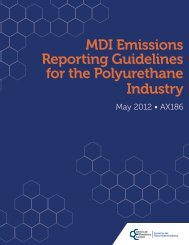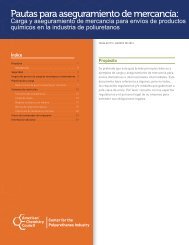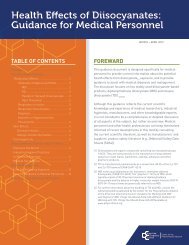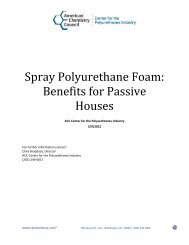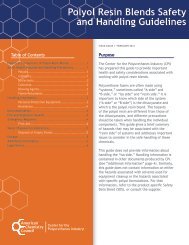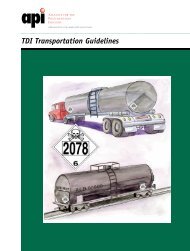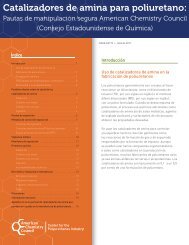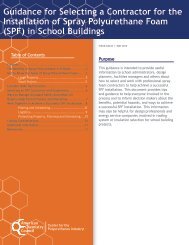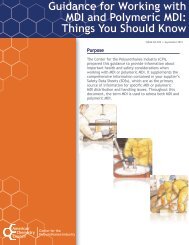MDI Transportation Guidelines - Polyurethanes - American ...
MDI Transportation Guidelines - Polyurethanes - American ...
MDI Transportation Guidelines - Polyurethanes - American ...
Create successful ePaper yourself
Turn your PDF publications into a flip-book with our unique Google optimized e-Paper software.
<strong>MDI</strong> transportation<br />
g u i d e l i n e s<br />
Chapter 4: Design and Construction of <strong>Transportation</strong> Equipment<br />
and Packaging<br />
4.1 Rail Tank Cars (RTCs)<br />
Rail tank cars used for the transportation of <strong>MDI</strong> must meet the U.S. Department of <strong>Transportation</strong>’s design<br />
and construction requirements for the transportation of hazardous materials. These requirements are found in<br />
49 CFR Part 179. The various subparts of Part 179 describe the requirements for construction material,<br />
welding, wall thickness, gaskets, valves, valve protection, and venting devices.<br />
Specific additional recommendations are as follows:<br />
• All fittings on Rail Tank Cars should be clearly labeled.<br />
• Tanks should be thermally insulated to minimize temperature fluctuations and provide extra protection in<br />
the event of fire or other accident.<br />
• Heating coils should be located on the exterior of the tank.<br />
• Tanks may be constructed of mild steel. The tanks may be internally lined.<br />
• Tanks should be fitted with 2-inch connections for vapor return lines.<br />
• Although the DOT’s Hazardous Materials Regulations permit bottom outlets, diisocyanate producers<br />
recommend only top outlets.<br />
• Pressure relief valves should be present and should be set to 75% of the pressure rating of the tank car.<br />
• If present, vacuum relief valves should be utilized to prevent negative internal pressure and should be set<br />
to 1 psig.<br />
• External fittings should have rollover or crash protection so that the tank car will not leak when involved<br />
in an accident.<br />
• Thermowells for temperature measuring devices should be present and have the appropriate relief<br />
devices to prevent spraying of product in the event of a malfunction of the thermowell.<br />
• Fittings should be available for pressurizing the car with dry nitrogen or dry air to assist in unloading or<br />
to apply a nitrogen blanket to prevent moisture ingress.<br />
• To prevent product contamination, it is recommended <strong>MDI</strong> not come in contact with aluminum, brass,<br />
copper, zinc, or their alloys.<br />
4.2 Cargo Tanks (Tank Trucks) and Inter-modal Bulk Tank Containers (ISOTainers)<br />
Cargo Tanks used for the transport of <strong>MDI</strong> must meet the design and construction requirements of the U.S. DOT.<br />
When <strong>MDI</strong> is shipped in a DOT specification container permitted by 49 CFR Part 173, it must conform to the<br />
applicable design specifications in Part 178.<br />
• Each tank must be fitted with a pressure relief device.<br />
• Each tank should be fitted with vacuum relief devices as prescribed in the appropriate section of the<br />
DOT’s regulations.<br />
Copyright 2001, <strong>American</strong> Plastics Council<br />
11



